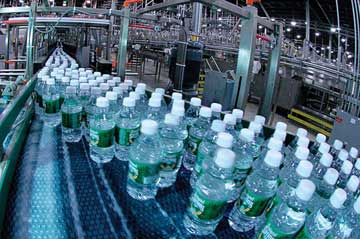
MAY 2005
Re-Use and Relocation (cover)
Mass. Finds Mutual Benefits in Redevelopment
A Brownfield in
Pittsfield Rises Again
Vermont Finds Good Fortune Near State Lines
Jewels and Barges Dot Rhode Island Project Landscape
Whose Side
Are You On?
LNG and Water On
Hold in Maine
'Fair and Workable'
Request Information

LNG and Water On Hold in Maine

|
| Nestlé Waters North America's Poland Springs operation is one of the more recognizable brands exported from the State of Maine. However, the company's proposed $100-million plant expansion and related springs development have met with opposition from citizen activists, who have proposed a tax on every bottle of water leaving the state. |
One of the biggest non-projects of the recent past was the vote-down by the residents of Searsport, Maine, on a proposed liquefied natural gas (LNG) terminal. While other LNG project proposals are still alive in and around Passamaquoddy Bay, it's another potential voter uprising that may stall yet another corporate project.
In this case, the company is one of the state's most recognizable brand names north of Freeport: Poland Spring, a bottled water brand of Nestlé Waters North America. The company would like to build a third bottling plant in Maine to supplement its two existing bottling plants in Hollis and Poland Spring.
But activists were at the ballot box in November and have been active with state legislators as well in an effort to introduce a referendum or law that would tax bottled water leaving the state to the tune of 20 cents per bottle.
Jane Lazgin, spokesperson for Nestlé Waters North America, says, "The company is in an active stage of investigation looking for potential sites, and is currently reaching out to local communities and officials in Franklin, Oxford and Somerset counties"
The new plant would cost about $100 million to build and employ from 100 to 250 at full build-out.
Lazgin says the referendum proposal held a "hollow promise," since so little of the proposed funds raised would go toward conservation. At the same time, she points out the cumulative $1.5 billion that the company has invested in the state, as well as its own stewardship. The company currently uses two-tenths of one percent of the state's water resources and employs 550.
The current search includes looking for spring sources as well as a plant site. "The availability of clean, abundant and high-quality spring water that matches the taste profile of Poland Spring and is from a protected source is critical to deciding where a plant would be located," says Lazgin. Other criteria include access to highways, proximity to northeast markets, and an available work force.
The process is being led by the company's natural resource manager, a certified geologist. The plant would likely start up by the end of the decade.